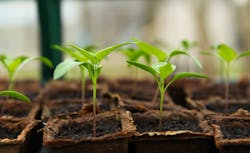Proposed CEA horticultural lighting policy may require LEDs in California
The State of California and its California Energy Commission (CEC) creates regulatory policy that mandates the most stringent energy-saving requirements in the world. The ongoing activity in the CEC for its 2022 Title 24 code cycle that would go into effect in January 2023 includes a virtual mandate that all new horticultural lighting use LED sources. Without question, such a mandate would save significant energy, but it would also require growers to make more costly upfront investments. The policy story will play out over the next couple of months.
California has been a solid-state lighting (SSL) trailblazer throughout the last decade as code accelerated the conversion to LED-based lighting. Indeed, California moved in 2011 to essentially ban incandescent lamps through efficacy (lm/W) limits a year before similar action took place across the US as part of the Energy Independence and Security Act (EISA) of 2007. Traditional incandescent replacement lamps could not meet the stringent efficacy requirements in the policy. And most of the world has followed California’s lead, albeit acting a year or two slower.
Back to the 2022 CEC code cycle, a Codes and Standards Enhancement (CASE) Initiative document has been circulated with a focus on horticultural lighting for controlled environment agriculture (CEA). The proposed policy is widely supported by California utilities across the state. That document covered environmental and AgTech issues beyond horticultural lighting, but we will focus on lighting here.
The previously linked document and a much briefer summary were prepared by the California Energy Codes & Standards program that is funded statewide by utility customers. The documents present yet another acronym — CEH (controlled environment horticulture). It seems the CEH moniker assumes that horticultural lighting is in use where there are many CEA installations that have no supplemental lighting. CEH would include both indoor grow installations and greenhouses with supplemental lighting, and span vegetables to flowers to cannabis.
Still, it seems the new policy concepts are driven primarily by cannabis and the disproportionate share of energy that cultivar is expected to consume. The summary document specifically mentions California’s legalization of cannabis in 2018 and the expected proliferation of indoor grow facilities in urban areas.
The proposed efficacy limits are quite straightforward, and remember we are talking horticultural efficacy and not lm/W that is tied to the human visual response. Photosynthetic photon efficacy (PPE) must be 2.1 µmol/J or better for indoor growing facilities that have 1000 ft2 or more of canopy. In greenhouses where both the sun and supplemental lighting are used, the policy is PPE of 1.7 µmol/J or better enforced in facilities with the same 1000 ft2 or more of canopy.
The proposed rulemaking has drawn some harsh criticism, mostly from the cannabis sector. Even in 2023, LED capex costs will remain far higher than legacy high-pressure sodium (HPS) lights. But we’ve seen cases where an investment in LEDs pays back in two years through energy savings. One such case was described in our article covering our Horticultural Lighting Conference 2018 (now called HortiCann Light + Tech).
Still, opponents of the rulemaking note the heavy burdens already placed on the California cannabis community such as testing requirements, license fees, taxes, and more. Those opponents of the CEC policy claim that it will be just one more force that keeps illegal growing and selling operations filling the majority of the California market.
But our reading of the proposed policy does not require existing operations to make an investment in LED lighting. The proposed rulemaking only applies to major upgrades of new builds. By the beginning of 2023, most growers would likely discover that LEDs would be the most profitable path forward in terms of new investments. Moreover, the horticultural efficacy specification aligns generally with the work of the DesignLights Consortium (DLC) in the horticultural space. Any utility or state incentives for horticultural lighting investments will require efficacy of 1.8 µmol/J.
Still, stakeholders and interested parties should watch the CEC process. You can submit a comment on the proposed rulemaking. A final decision should come down at the end of October. A spokesperson from the CEC said there will likely be a workshop held on the proposed rulemaking in the coming months. To learn of such events, you can register to receive CEC email notices of coming events and deadlines.
Meanwhile, it will be interesting to see if the rest of the US follows California and the CEC in this case. A lot may depend on the US Presidential Election. Under the Trump administration, the US Department of Energy has sought to rollback general lighting efficacy policy and many other energy use policies.
We will cover regulatory policy and energy usage as just one element of the horticultural sector at our upcoming HortiCann event. For the first time, we will hold the event virtually so no travel is required. Register and join us Oct. 20–21.
For up-to-the-minute LED and SSL updates, why not follow us on Twitter? You’ll find curated content and commentary, as well as information on industry events, webcasts, and surveys on our LinkedIn Company Page and our Facebook page.

Maury Wright | Editor in Chief
Maury Wright is an electronics engineer turned technology journalist, who has focused specifically on the LED & Lighting industry for the past decade. Wright first wrote for LEDs Magazine as a contractor in 2010, and took over as Editor-in-Chief in 2012. He has broad experience in technology areas ranging from microprocessors to digital media to wireless networks that he gained over 30 years in the trade press. Wright has experience running global editorial operations, such as during his tenure as worldwide editorial director of EDN Magazine, and has been instrumental in launching publication websites going back to the earliest days of the Internet. Wright has won numerous industry awards, including multiple ASBPE national awards for B2B journalism excellence, and has received finalist recognition for LEDs Magazine in the FOLIO Eddie Awards. He received a BS in electrical engineering from Auburn University.





